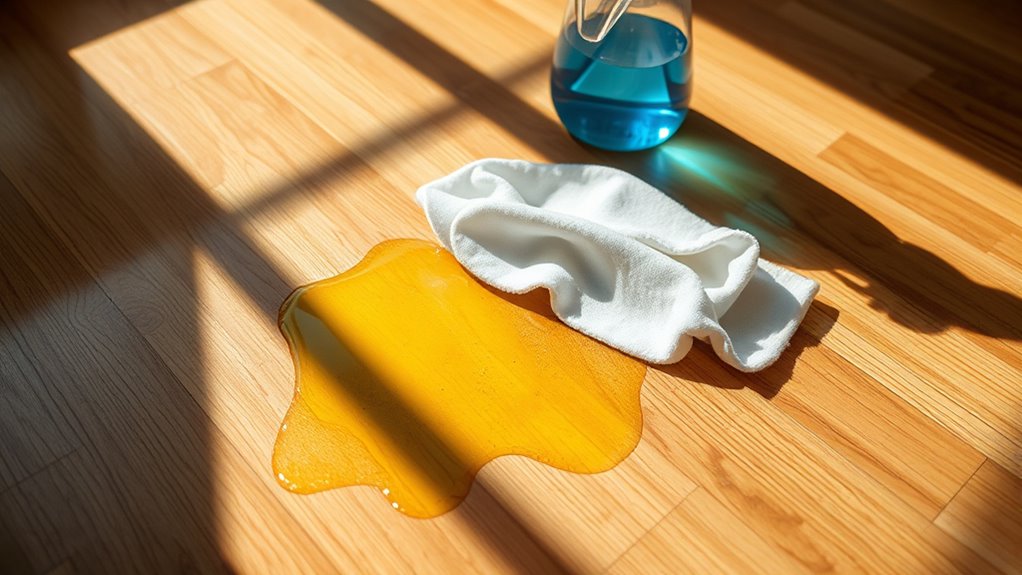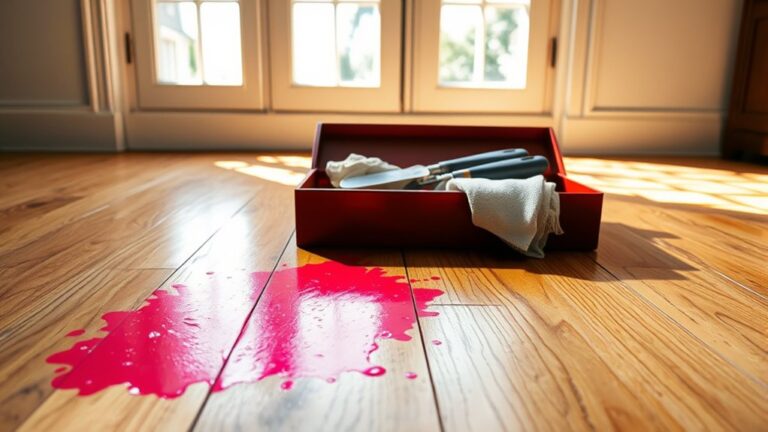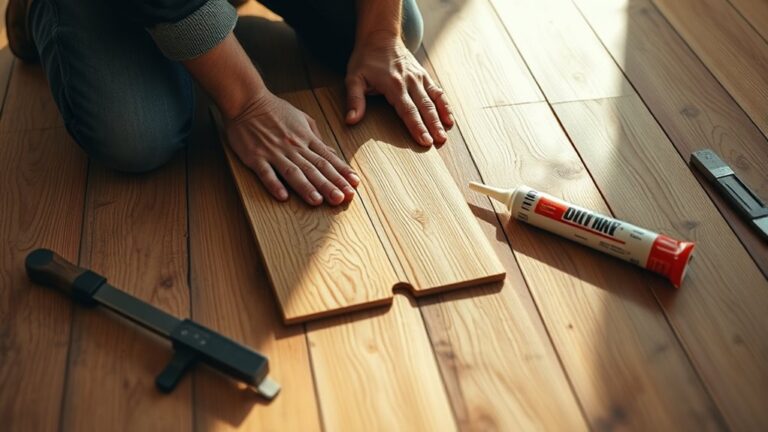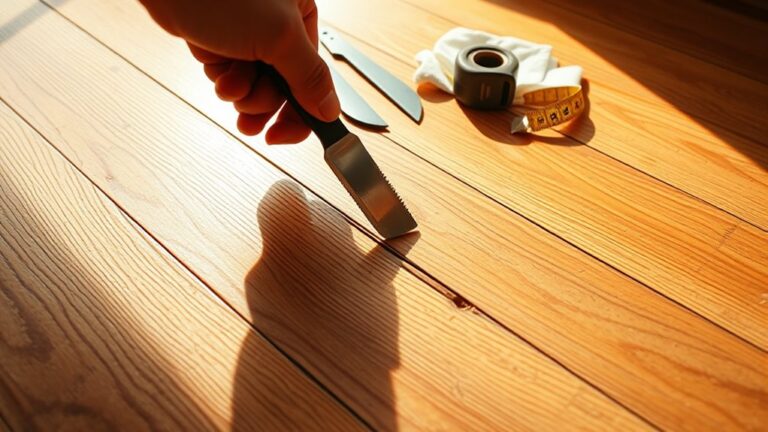To get rid of urine stains on hardwood floors, first blot the area gently to soak up moisture without spreading it. Then, apply a vinegar-and-water solution to neutralize odors, followed by sprinkling baking soda to absorb remaining dampness. For stubborn stains, 3% hydrogen peroxide works well when applied carefully. Avoid harsh chemicals and consider sanding if deep staining persists. Following these steps guarantees effective cleaning and preservation—you can explore further to protect and restore your floors fully.
Identifying the Severity of Urine Stains on Hardwood
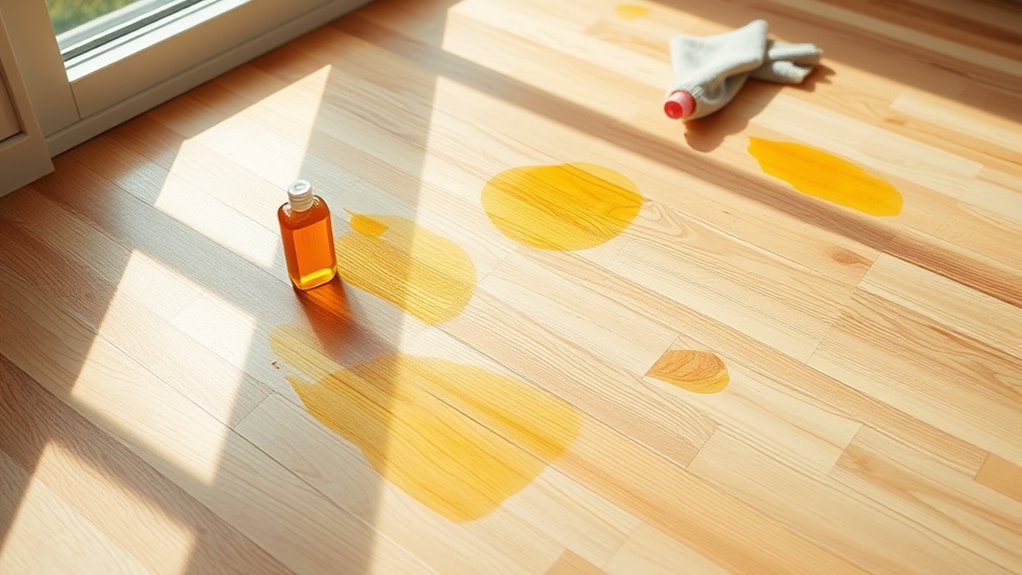
How can you determine the severity of urine stains on your hardwood vloer? Start by identifying discoloration patterns—look closely for yellowing or dark spots that differ from your floor’s natural tone. Use a flashlight at an angle to reveal subtle changes in the wood’s surface. Next, evaluate wood damage by gently pressing the affected area; softness or warping indicates deeper harm. Check if urine has penetrated the finish, causing the wood to swell or crack. Mapping the extent of the stain helps you decide the right cleaning or restoration method. By carefully identifying discoloration and evaluating wood damage, you gain control over the problem, enabling you to choose solutions that preserve your floor’s integrity and maintain your home’s freedom from lingering stains.
Immediate Cleaning Steps for Fresh Urine Spills
When you notice a fresh urine spill, start by gently blotting the area with a clean, absorbent cloth to soak up as much liquid as possible without spreading it. Next, apply a safe cleaning solution specifically designed for hardwood floors, ensuring it won’t damage the finish. Following these steps promptly will help prevent stains and lingering odors.
Blotting Techniques
Although it might seem urgent to scrub the spot immediately, you should start by gently blotting the urine spill with a clean, absorbent cloth or paper towel. Effective blotting methods rely on using the right absorbent materials to avoid pushing the urine deeper into the wood. Follow these steps carefully:
- Press the cloth firmly onto the spill without rubbing to soak up as much liquid as possible.
- Replace the cloth as it becomes saturated to prevent re-wetting the area.
- Continue blotting until no more moisture transfers to the cloth.
These precise blotting techniques help you free your hardwood floor from excess urine quickly and minimize the risk of stains or damage, giving you the liberty to move on to deeper cleaning confidently.
Veilige reinigingsoplossingen
Once you’ve carefully blotted the urine spill to remove excess moisture, the next step involves applying a safe cleaning solution to prevent stains and odors. You can rely on natural remedies like a mixture of white vinegar and water—combine one part vinegar with three parts water for an effective, eco friendly solution. Gently apply this to the affected area using a soft cloth, avoiding over-saturation that might damage the wood. Let it sit for 5-10 minutes to neutralize urine acids, then blot dry. Alternatively, a paste made from baking soda and water can absorb moisture and odors without harsh chemicals. Using these natural remedies guarantees your hardwood floor remains undamaged while you maintain a fresh, stain-free surface—giving you the freedom to enjoy your space without worry.
Using Vinegar and Water Solution to Neutralize Odors
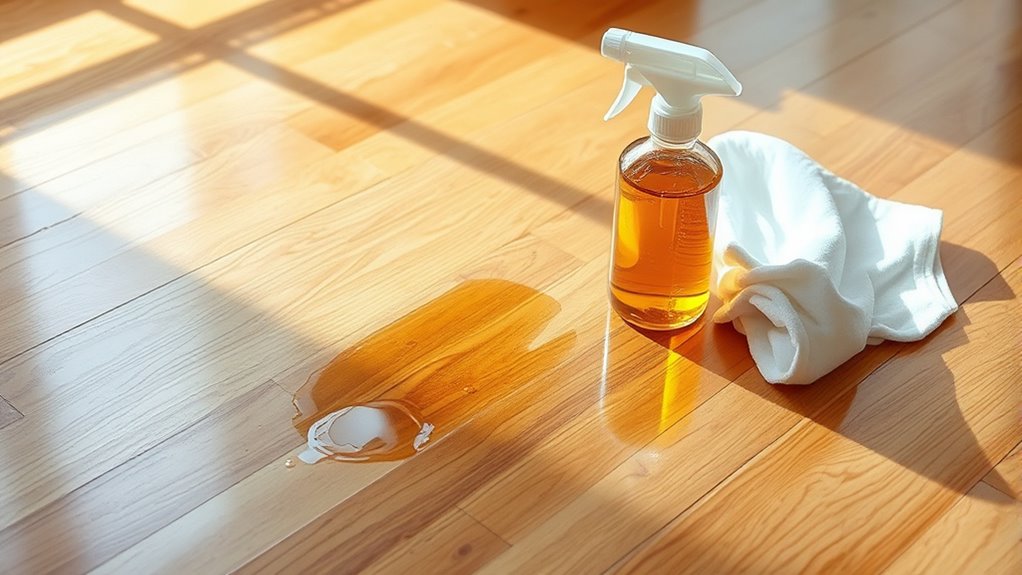
Start by mixing one part white vinegar with one part water to create an effective odor-neutralizing solution. Apply this mixture evenly over the stained area using a spray bottle or cloth, ensuring the liquid penetrates the wood without soaking it. Let it sit for 5 to 10 minutes before wiping it dry to eliminate lingering urine odors efficiently.
Mixing Vinegar Solution
To effectively neutralize odors from urine stains on hardwood floors, you’ll need to prepare a vinegar solution by mixing one part white vinegar with two parts water. This balance is essential because vinegar benefits include neutralizing alkaline urine odors without damaging your wood finish. Follow these steps to get the solution right:
- Measure the vinegar and water using a clear container for accuracy.
- Pour one cup of white vinegar into the container.
- Add two cups of water to maintain the proper solution ratios.
Sticking to this precise mixture guarantees the solution is strong enough to combat odors while gentle enough to protect your floors. This method offers you the freedom to clean confidently, knowing you’re using a natural, effective approach tailored to your hardwood’s needs.
Toepassingstechnieken
Two key application techniques will guarantee your vinegar and water solution effectively neutralizes urine odors on hardwood floors. First, use a soft-bristle brush or microfiber cloth as your cleaning tools to gently apply the mixture directly onto the urine stain. Avoid saturating the wood; a light, even layer guarantees the solution penetrates without damaging the floor. Second, allow the solution to sit for 5 to 10 minutes, giving it time to break down the stain and neutralize odors. Afterward, use a dry microfiber cloth to carefully blot the area, removing excess moisture and preventing further damage. These precise steps maximize stain removal while preserving your floor’s finish, letting you reclaim your space with freedom from unpleasant odors.
Odor Neutralization Tips
One effective way to neutralize urine odors on hardwood floors is by using a vinegar and water solution with careful attention to dilution and timing. Vinegar’s natural acidity aids in scent absorption rather than mere odor masking, breaking down molecules causing the smell. Follow these steps:
- Mix one part white vinegar with four parts water to guarantee the solution isn’t too harsh for your hardwood.
- Apply the solution lightly with a spray bottle or cloth, avoiding saturation to protect the wood.
- Allow it to sit for 5–10 minutes, then blot dry immediately to prevent moisture damage.
Applying Baking Soda to Absorb Moisture and Smells
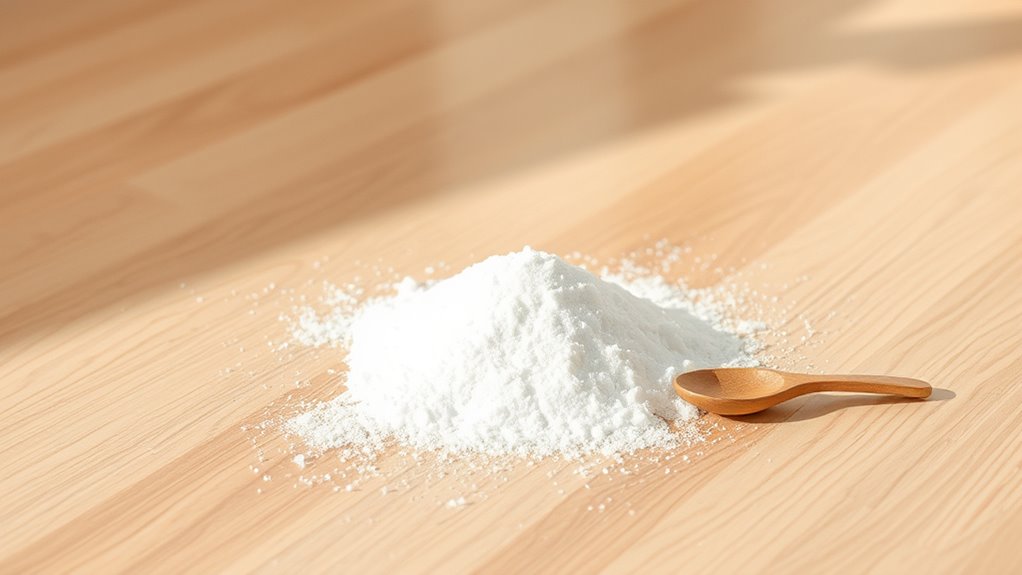
Before wiping away any moisture, sprinkle a generous layer of baking soda directly onto the urine stain. This step is essential because baking soda excels at moisture absorption, helping to draw out liquid trapped in the hardwood’s pores. Apply it evenly to cover the entire affected area. Allow the baking soda to sit undisturbed for several hours—ideally overnight—to maximize its ability to soak up moisture and neutralize odors. After this waiting period, gently sweep or vacuum the powder without pressing it deeper into the wood. This methodical approach not only reduces dampness but also helps prevent lingering smells, giving you greater control over the cleanup. Using baking soda this way supports your goal of restoring freedom to your space, free from urine stains and odors.
Treating Stubborn Stains With Hydrogen Peroxide
Although baking soda can effectively absorb moisture and reduce odors, some urine stains may require a stronger treatment to fully eliminate discoloration. Hydrogen peroxide offers a powerful solution for stain removal without harsh chemicals. Here’s how to apply it methodically:
- Pour a small amount of 3% hydrogen peroxide directly onto the stubborn stain, ensuring the area is well saturated but not flooded.
- Let it sit for 5-10 minutes to allow the oxidizing action to break down the urine compounds causing discoloration.
- Blot the area gently with a clean cloth, absorbing the liquid and lifting the stain from the wood fibers.
Repeat if necessary, but always test a hidden spot first to avoid damage. This process frees you from lingering stains, restoring your hardwood’s natural beauty with precision.
Sanding and Refinishing Deep Urine Stains
When urine stains have penetrated deeply into your hardwood floors and surface treatments haven’t worked, sanding and refinishing becomes necessary to fully restore the wood. Start by selecting the right sanding techniques: use a coarse-grit sandpaper to remove the stained top layers, then progressively finer grits to smooth the surface evenly. Be thorough but cautious to avoid damaging the floor’s integrity. After sanding, clean the dust completely before moving on. Next, explore refinishing options—choose a stain or sealant that complements your flooring while providing protection against future damage. Apply these coatings evenly, allowing adequate drying time between coats. This methodical approach frees your floors from stubborn stains and revitalizes their natural beauty, giving you lasting freedom from unsightly urine marks.
Preventing Future Urine Stains on Hardwood Floors
Since hardwood floors are vulnerable to urine damage, taking proactive steps is essential to prevent future stains. You can implement effective preventive measures and urine deterrents to safeguard your floors. First, establish a routine cleaning schedule to eliminate odors that attract pets. Second, apply specialized urine deterrent sprays in vulnerable areas; these disrupt your pet’s habit of marking. Third, use washable area rugs or mats strategically placed in high-risk zones to protect the wood beneath. These methodical steps reduce the likelihood of accidents and stains. By integrating these three strategies—consistent cleaning, deterrent application, and protective coverings—you’ll maintain your hardwood’s integrity and freedom from unsightly urine stains, ensuring your floors stay pristine and your living space fresh.
Choosing the Right Cleaning Products for Hardwood
Selecting the right cleaning products is essential to preserving your hardwood floors while effectively removing urine stains. You’ll want to focus on cleaning product types designed specifically for hardwood safe options. Avoid harsh chemicals like ammonia or bleach that can damage the wood finish or cause discoloration. Instead, opt for pH-neutral cleaners or enzymatic solutions that break down urine compounds without harming the floor. Water-based cleaners with gentle surfactants work well, but always test on a small area first. Using a microfiber cloth or mop helps prevent scratching. By choosing hardwood safe options carefully, you maintain your floor’s natural beauty and extend its life, all while confidently tackling stubborn urine stains without risking irreversible damage or unwanted residues.
When to Call a Professional for Hardwood Floor Restoration
If you’ve tried various cleaning methods but the urine stains still linger or the wood finish appears damaged, it’s a clear sign you might need professional hardwood floor restoration. Knowing when to consult professionals is vital to preserve your floor’s integrity and your freedom from ongoing hassle.
When urine stains persist and finishes falter, professional hardwood restoration becomes essential for lasting floor care.
Look for these signs of damage to decide when to call an expert:
- Persistent discoloration or deep stains that resist all cleaning attempts.
- Warping, cupping, or bubbling of the wood surface indicating moisture damage.
- Worn or cracked finish that exposes bare wood to further harm.
Addressing these issues early by consulting professionals guarantees your hardwood floors regain their beauty and durability without compromising your time or peace of mind.

